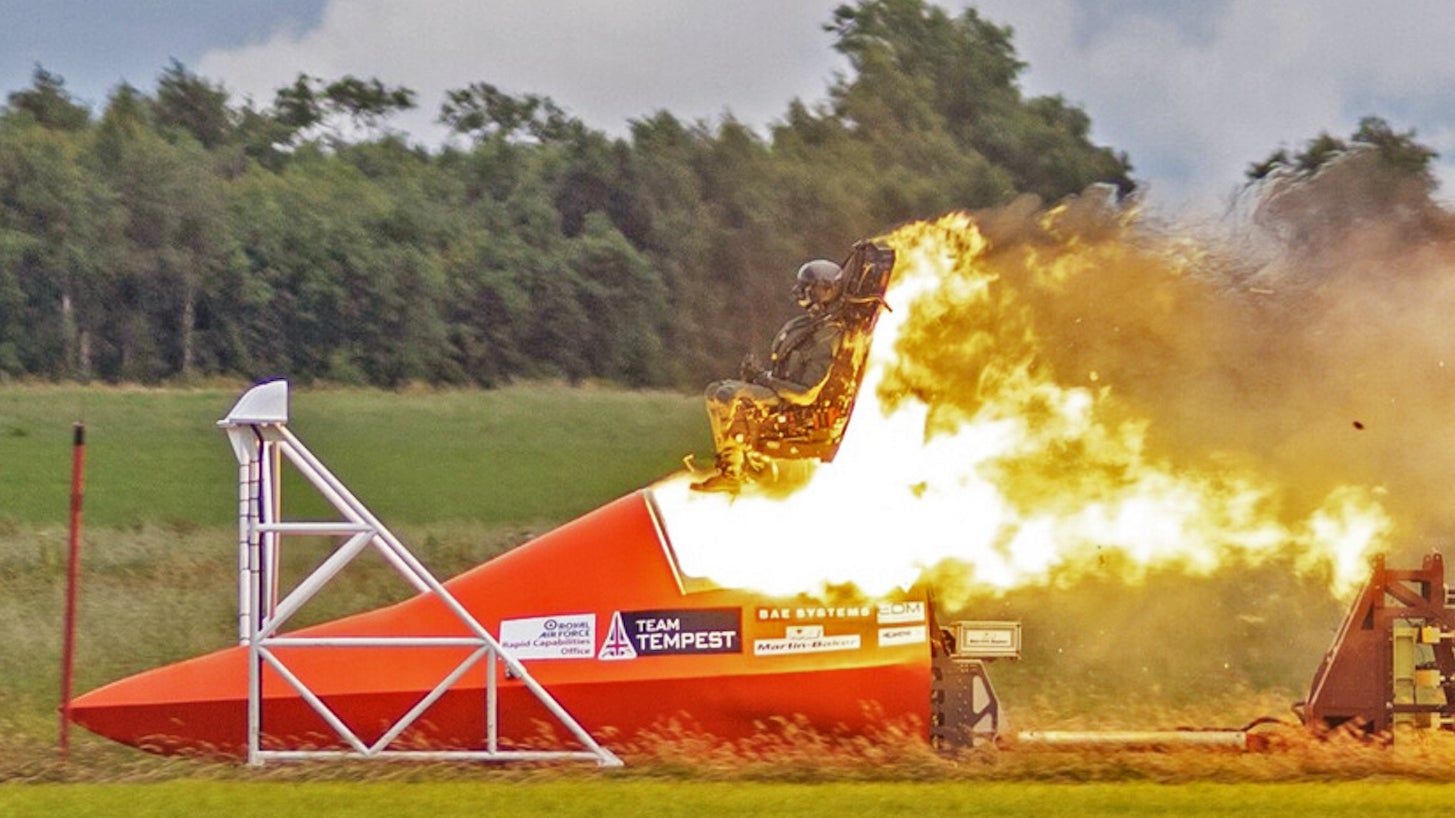Tempest Fighter Begins To Take Shape With Ejection Seat Tests
Development work on the British-led Tempest future stealth fighter is gathering pace, including trials of a Martin-Baker ejection seat using a rocket sled. Tests of the crew escape system provide very tangible — and dramatic — evidence of progress made in the program so far. However, it is just one element of a multi-faceted development effort that will face many challenges if it’s to succeed in getting a new-generation crewed fighter into service by 2035, as planned.
The video and photos of the ejection seat trials were released today by program lead BAE Systems, together with details about other work taking place on the program. The ejection seat will be used in a Flying Technology Demonstrator, which will inform the Tempest. Plans for a supersonic crewed demonstrator aircraft were first announced in July 2022, together with the aim of having it flying by 2027.
The moment of ejection during one of the rocket sled tests for the Flying Technology Demonstrator. BAE Systems
The demonstrator will use the same Martin-Baker Mk 16A ejection seat used in the Eurofighter Typhoon fighter jet. Work on the crew escape system began in February 2022 with static firing to evaluate the cockpit canopy — which incorporates technology from BAE’s Hawk advanced jet trainer. There were then four tests using a rocket-propelled sled, with differently weighted instrumented mannequins being ejected at 280 knots and 450 knots.
Work on the crew escape system is now complete. It seems that the fuselage section used in the ejection will be broadly the same as that in the demonstrator, being described as a “representative forward fuselage design,” and a degree of commonality would be required for the tests to be productive.
The “representative forward fuselage design” used for ejection tests, coupled to the rocket sled. BAE Systems
A BAE “representative military fast jet fuselage” that was built on a high-tech, heavily automated new production line. BAE Systems
However, it’s unclear to what degree the demonstrator will actually look like the Tempest. Already, there have been significant changes in the appearance of conceptual studies and mock-ups representing the Tempest, as you can read about here.
To get the Flying Technology Demonstrator into the air in the next four years, BAE and other entities working on the program (including Rolls-Royce, Leonardo UK, MBDA, and the U.K. Ministry of Defense) are using “a range of innovative digital techniques and transformative processes,” according to BAE.
Digital engineering has in recent years been billed as the key to enabling the rapid development of new aircraft and other weapon systems. While it may not always be the panacea that some have claimed — something that you can read about in-depth here — BAE is confident that this approach will allow the timeline to be met.
In particular, the digital processes include auto-coding, in which entire program codes are created automatically. BAE says it’s the first time that this approach has been used in military aircraft design and is being leveraged to “create safety-critical systems software in a matter of days rather than weeks.” This software is then proven in a simulator, testing for example the behavior of flight control systems during complex flight maneuvers. In this way, designers hope to know much about how the Flying Technology Demonstrator handles and performs before it’s flown.
An earlier concept for the Tempest future fighter jet. BAE Systems
A simulator has been developed especially for the project and is located at a new facility at BAE Systems in Warton, Lancashire. The company says that a digital representation of the Flying Technology Demonstrator has flown more than 170 hours in the simulator, with a team of 10 pilots provided by BAE, Rolls-Royce, and the U.K. Royal Air Force (RAF).
Work is also pressing ahead on the powerplant for the demonstrator. Aerodynamic engine testing has already taken place at Rolls-Royce’s site in Filton, Bristol. The engine used in the tests was a standard Eurojet EJ200 from a Typhoon fighter, although it’s not clear if this will also be used in the twin-engine Flying Technology Demonstrator. The Tempest, also twin-engine, is set to feature an all-new engine design.
The powerplant system for the demonstrator also incorporates novel technologies, including using “advanced manufacturing processes” to produce the engine duct for the intake. The intake is designed to use a smaller number of moving parts to slow down air from supersonic to subsonic speeds before it meets the engine. The intake serpentine design is an important aspect to ensure the aircraft’s stealth characteristics.
The EJ200 engine combined with the engine duct for the demonstrator aircraft, at Filton in Bristol. BAE Systems
As it stands, we don’t have any concept artworks or models available to see what the Flying Technology Demonstrator will actually look like. However, at almost 33 feet long, the engine duct suggests an overall large airframe. We also know that it will specifically test features including the crew escape system, engine intake, and stealth technologies, which will be based on low-observability shaping and materials. Those features will then inform the design of the Tempest, although there may well be significant changes between the demonstrator and the production fighter.
An infographic showing some of the capabilities and concepts behind the Tempest program. BAE Systems
While the Flying Technology Demonstrator is currently a British effort, BAE has also said that, in the future, Italy and Japan could come aboard, reflecting the tri-national nature of the broader Global Combat Air Program (GCAP) of which the Tempest is a fundamental part, but which also involves other technologies, among them ‘loyal wingman’ type drones, a new generation of air-launched weapons, and sensors.
Since the demonstrator aircraft was first announced in July 2022, the GCAP collaboration between the United Kingdom, Italy, and Japan has taken shape and this is now central to the success of the program.
At this point, however, it’s not exactly clear how the three partner nations will divide up the workshare and costs of GCAP. Last summer, it was reported that the U.K. Ministry of Defense had already committed around $2.5 billion to the GCAP until 2025, with Italy and Japan each said to have matched this investment.
But even with Italy and Japan now involved, to help share costs and boost demand for Tempest aircraft and ancillary systems, there remain big questions about the feasibility of creating a new fighter jet and supporting architecture from scratch, especially one that’s supposed to be in service by 2035.
An official artist’s concept of a potential GCAP configuration, with Mount Fuji in the background. MHI
In the past, there have been tentative suggestions from the U.K. government that other countries may buy into GCAP in the future, either signing up as partners or committing to buy Tempest aircraft as export customers. With the United Kingdom experiencing an economic downturn, any such developments would be welcome. But it’s not clear what countries might join in.
Sweden was previously interested in the U.K.-led Future Combat Air System, or FCAS framework that preceded GCAP. Today, however, Sweden is no longer being mentioned as part of GCAP, raising doubts about its involvement.
Then there are the persistent questions about how realistic it is for there to be two separate future combat air efforts being run simultaneously in Europe. As well as the U.K.-led FCAS (which now appears to have essentially morphed into GCAP), France, Germany, and Spain are pursuing a rival pan-European FCAS. The European FCAS also has a crewed fighter jet as its centerpiece, known as the Next Generation Fighter (NGF).
In the past, the chief of the Italian Air Force raised the possibility of some kind of merger between the two FCAS programs, arguing that “investing huge financial resources in two equivalent programs is unthinkable.” At this point, such a development seems unlikely, but with some political tensions within the pan-European FCAS, it can’t be ruled out entirely.
One of the more recent concept artworks of the Tempest fighter released by BAE Systems. BAE Systems
Meanwhile, with plenty of other technologies being developed alongside the crewed fighter jets, there would seem to be no shortage of options for collaborating on other elements, such as uncrewed aircraft or air-launched weapons, for example.
Aside from possible developments on the political and industrial side of the program, the latest announcements make it clear that BAE and its partners are now pushing ahead to get a demonstrator for the Tempest in the air by 2027.
It’s no secret, however, that developing a stealth combat aircraft from scratch is an extremely complex undertaking, with long development times and high costs essentially baked in from the start. With that in mind, the timelines are clearly ambitious, but it will be fascinating to see what happens next, not least how the Flying Technology Demonstrator will actually appear, and what other kinds of technologies it will incorporate.
Ultimately, the hope will be that this intermediary design will accelerate work on the final product and help keep up Tempest’s aggressive schedule.
Source: The War Zone


